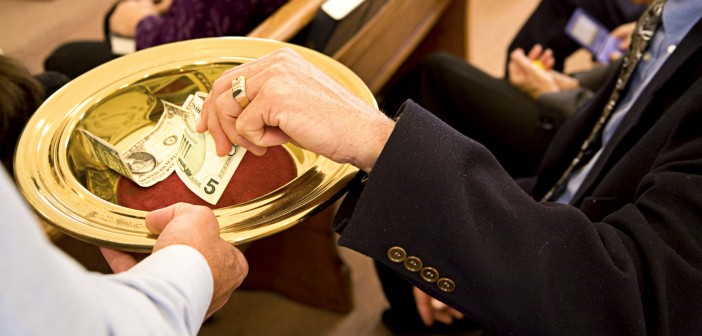Helping people experience the joy of giving is more than a way of funding the church’s ministry. These 50 Ways of encouraging faithful giving will help your church members grow in discipleship through faithful stewardship and extravagant generosity.
Stress the spiritual dimension of stewardship
- Teach stewardship as a holistic model of our relationship with God, as the tangible expression of our trust in God. Giving is a spiritual matter as central to faithful living as prayer, Bible study, and worship.
- Reinforce giving as an act of worship. Use the offering time to lift up the spiritual significance of giving. Take an offering at every service.
- Set a good example. The pastor should tithe and encourage other ministers, staff, and leaders to do the same. All leaders must take their giving seriously and model generosity.
- Talk openly about money and faithfulness to God. If leaders are uncomfortable about money then members will be also. Know your story of giving and be willing to testify about it.
- Model the giving spirit you seek from members in your church budget by giving generously to ministries beyond the congregation.
- Teach the theology of stewardship through a variety of means — church school classes, other study venues, sermons, and correspondence. Use stewardship scripture, quotations, and stories in bulletins, newsletters, other printed materials, and the website.
Know what motivates giving
- Know that people give to many things for a variety of reasons. Few have a well-planned or consistent giving strategy. Some give on impulse. Others are more cautious. Different kinds of appeals are effective with different types of givers.
- Recognize that people want to make a difference. They will give to what they value.
- Appreciate that faithful giving is a fruit of spiritual maturity. It takes time and much nurture to develop.
- Do not engage in fund raising. People give to God, not to raise the preacher’s salary or pay the utilities. Don’t make church gifts “one more bill to pay” — a bill that can be skipped without late fees, penalties, or the need to catch-up. Emphasize giving as a joyful response to God’s generosity, not an obligation.
- Talk to members about stewardship and opportunities for giving. Most people never increase their giving because they were never asked, nor given compelling reasons to do so. Don’t be afraid to lift up the needs of the church, but always in a way that emphasizes mission.
- Nurture relationships. People give to persons and organizations where they feel a connection. Church leaders should listen carefully for clues about issues of importance to church members. Personal solicitation is critical, especially for larger gifts.
Link stewardship to mission and ministry
- Remember that people — especially younger generations — give to support mission, not institutions or budgets. Everything you communicate about giving should stress ministry, not maintenance.
- Congregational vitality is key to giving. Whatever increases member involvement and participation will help giving. Involve as many as possible in the church’s ministries.
- Share information freely about the wonderful things giving makes possible. Use announcements to remind people of the impact they are having. Bulletin boards featuring how the church is in mission are good reminders to a congregation. Websites offer ways to tell the church’s story and to interpret stewardship and giving.
Know your givers and congregational giving patterns
- Do not make assumptions about what people give — most of the time you will be wrong.
- Give your pastor access to members’ giving records as a matter of pastoral care, not power or privilege.
- Keep alert for any changes in giving patterns — if giving stops without explanation, if an adult child starts writing checks for their parents, if there is confusion about giving, if designated gifts replace general giving, etc. Notify the pastor of any potential pastoral care concerns.
- Know your people and approach them where they are. Someone who has never given does not respond in the same manner as someone who gives faithfully, proportionately, and generously.
- Understand the financial profiles in your community. If few people carry cash, a spur of the moment offering will not succeed. Remember that more women than men carry a checkbook and younger generations are more inclined to pay by electronic or other non-cash means. A 25 year-old is unlikely to make a stock gift, while an older member on a fixed income may prefer an estate gift to one that reduces their monthly income.
- Monitor giving Indicators throughout the year. Compare pledge payments with those of previous years.
- Know how actual income compares to budgeted income for a given time of year. Avoid reporting what is “needed to date” by dividing the total budget into equal monthly or weekly segments. No congregation receives its income so evenly. Instead, determine how much income is “needed to date” based on a rolling three-year average of what percent of total giving is normally received during that period.
Provide a variety of ways to give
- Give people multiple opportunities to give. Those new to the church may be unfamiliar with the concept of pledging and tithing. Other ways of giving can get them in the habit.
- Consider sending some appropriate communication a few times a year to those who do not pledge and to non-resident members.
- Remember that people can give from their income, from their assets (stock, 401Ks, bonds and real property), or through legacies or bequests. Create giving opportunities appropriate to each type of gift.
- Don’t wait decades between capital campaigns. More frequent capital drives create a culture of supporting the church’s capital needs and prevent neglect of property concerns.
- Create a foundation or permanent fund, even if you have not yet received any bequests. People cannot give to what does not exist. Formulate policies for wills, legacies, and bequests. A large estate gift can be divisive if proper procedures are not in place.
Assist members in the stewardship of their personal resources
- Remember that personal finances and spending decisions are as much a part of Christian stewardship as giving to the church. Too often churches ask people to consider the church’s financial situation, but seldom offer to help with members’ financial situations.
- Teach members to think about their finances as an expression of faith. Use appropriate study resources to foster a theology of personal stewardship. Reinforce tithing and “first-fruits” giving as a faithful way of prioritizing one’s personal finances – not a way to pay church bills.
- Offer workshops on budgeting, financial management, and estate planning.
- Encourage sessions in which members can come together to discuss personal financial challenges. For example, parents of students preparing for college could discuss educational funding options. Those responsible for aging parents could come together to talk with other members who have learned of resources to help.
- Minister to the economic concerns of parishioners. Provide pastoral assistance and support groups for the unemployed, those in career transition, and those facing financial difficulty.
Develop a year-round, comprehensive stewardship program
- Preach stewardship sermons throughout the year, not just in the weeks before asking for an estimate of annual giving.
- Know that developing a congregation of faithful givers does not happen during a three to four-week stewardship drive. People do not become faithful stewards in one moment or through one influence.
- Create an annual stewardship calendar, emphasizing different stewardship concerns at different times of year – such as annual commitment in the fall, second-mile giving at year-end, planned giving at All Saint’s Day, etc. Develop stewardship themes that fit with different church events and liturgical seasons.
- Encourage faithful giving over the summer by preaching on stewardship the last Sunday before school is out. Everyone knows the churches bills do not go on vacation, so quit reminding your members of that.
- Make giving and stewardship education a part of your ministry with children and youth.
- Take the time to do everything related to stewardship well. Poor planning results in poor giving. Inspire generosity through sound management
- Know that people give to healthy organizations where they know their money is used wisely.
- Exhibit honesty and openness in financial interactions.
- Seek a good working relationship based on trust between the pastor, treasurer, and financial secretary.
- Make sure at least two unrelated people count the offering each week.
- Make sure all funds are administered properly. Keep precise records of income and dispersements. Keep your giving records secure.
- Keep the congregation informed of financial matters in meaningful ways. Issue timely financial reports and make them available to any member who requests them. Report financial concerns in a consistent manner.
- Send out pledge reports/giving statements in a timely fashion, always with a thank you and a reminder about any update that may be needed.
- Arrange for an independent audit or review of funds annually. Put a brief announcement in the Sunday bulletin a few times stating the completed audit has been reviewed by the finance committee and is available to members wishing to review it.
Say thanks often
- Find multiple occasions and ways to say “thank you” to those who make the church’s ministry possible — from the pulpit, in person, in the newsletter, and on their giving statements.
- Conduct an annual “thank-a-thon” not associated with a fund drive.
- Tell stories of how lives are changed because of their giving. People need to know their giving makes a difference.
- As a sign of appreciation, make sure all your procedures for giving are as convenient as possible. Avoid procedures and policies that are for the convenience of those who handle the funds rather than those who give the funds.




